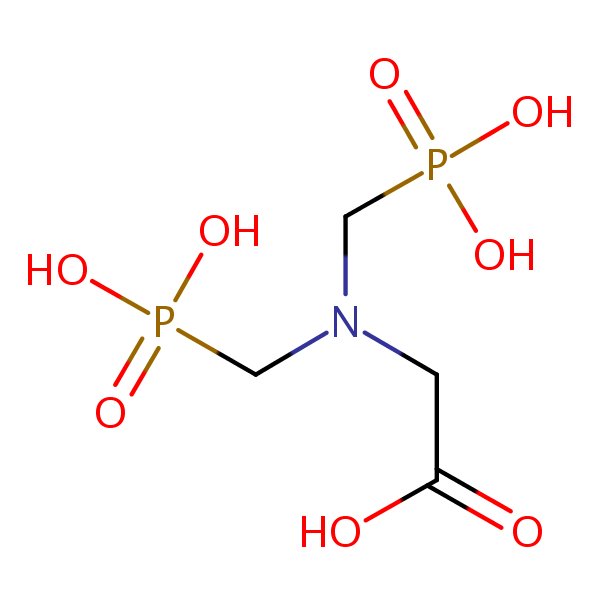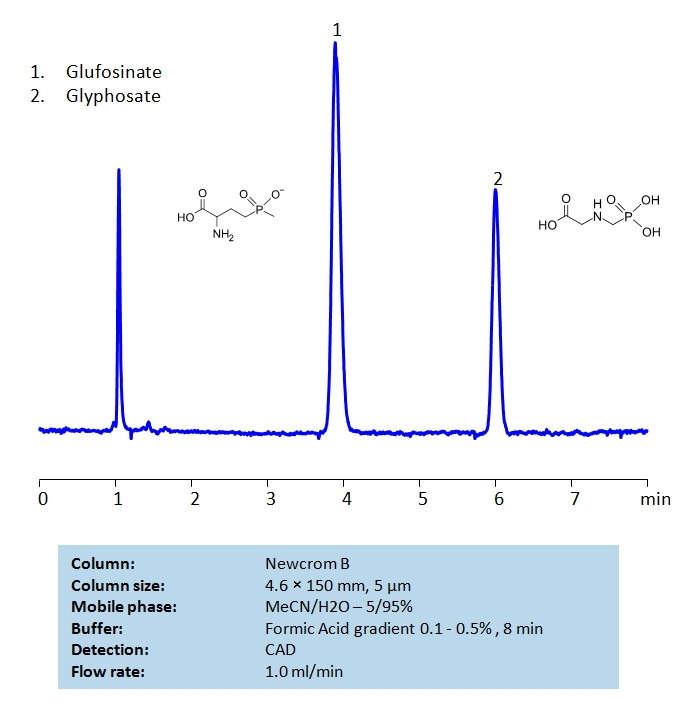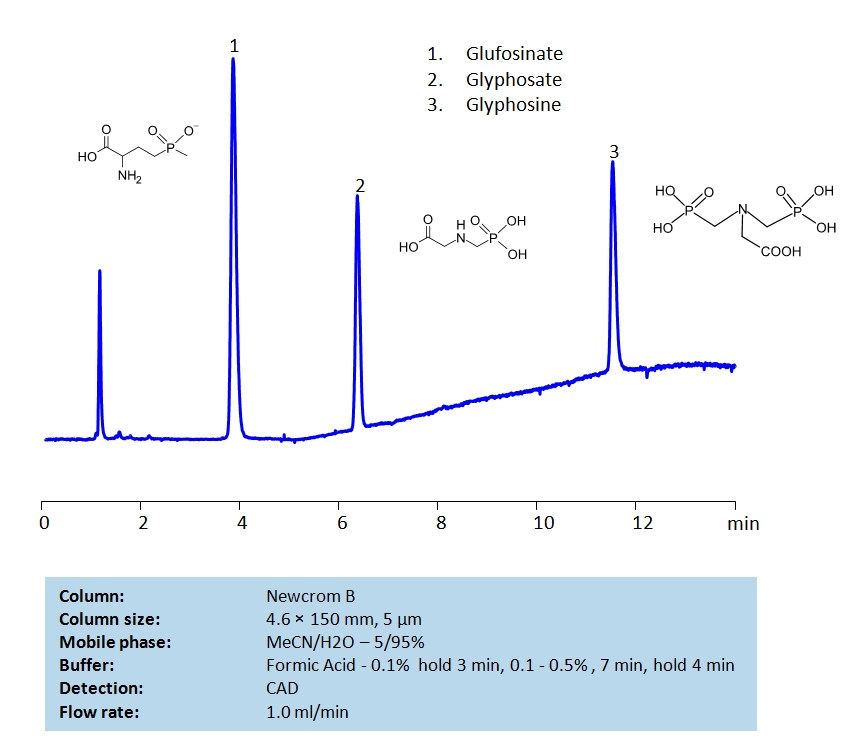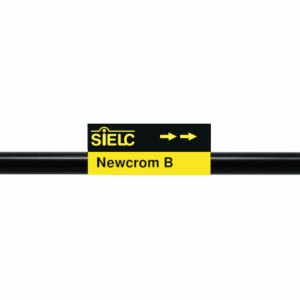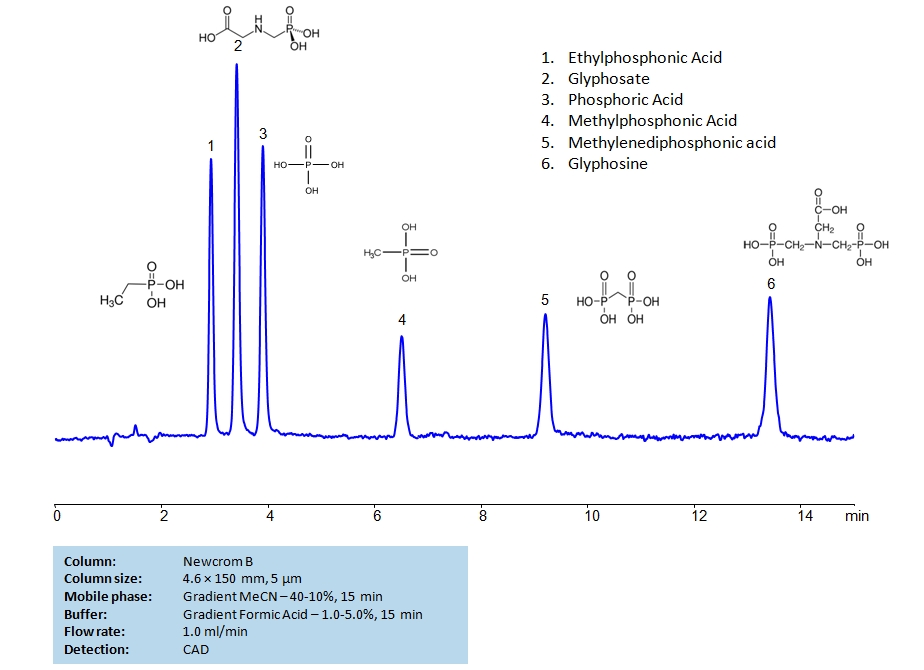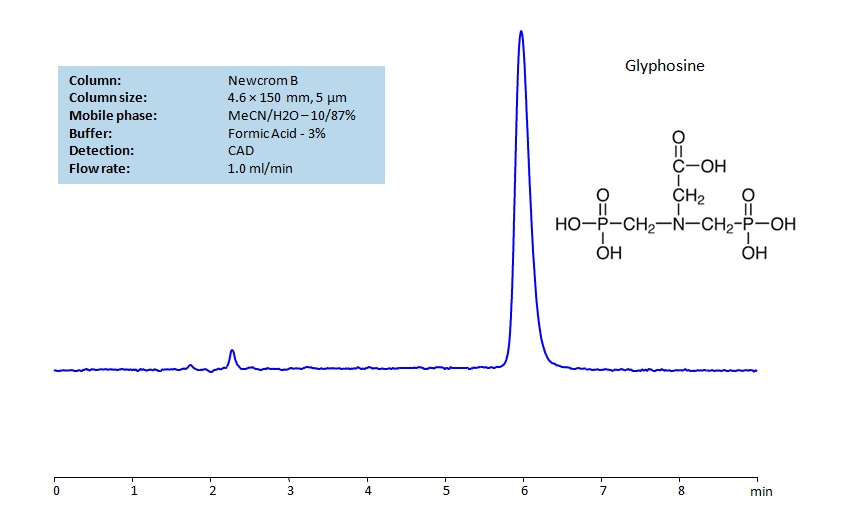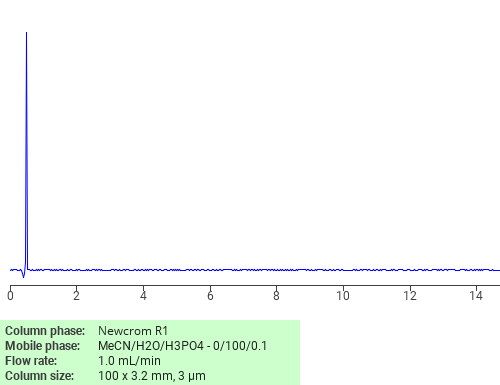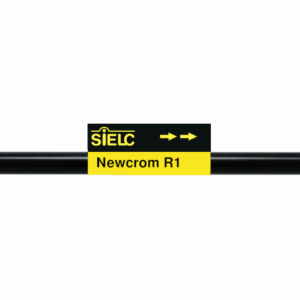| CAS Number | 2439-99-8 |
|---|---|
| Molecular Formula | C4H11NO8P2 |
| Molecular Weight | 263.080 |
| InChI Key | OXHDYFKENBXUEM-UHFFFAOYSA-N |
| LogP | -3.38 |
| Synonyms |
|
Applications:
HPLC Separation of Glufosinate, Glyphosate and Glyphosine on Newcrom B Column
December 10, 2020
HPLC Method for Glufosinate, Glyphosate, Glyphosine on Newcrom B by SIELC Technologies
High Performance Liquid Chromatography (HPLC) Method for Analysis of Glufosinate, Glyphosate, Glyphosine.
Glufosinate is a naturally occurring herbicide. It is produced by Streptomyces soil bacteria and is used for weed control against broadleaf and grass weeds. It’s chemical formula is C5H12NO4P. The herbicide works through inhibiting glutamine synthetase, which is a key enzyme in plant metabolism. It is a sky and eye irritant, therefore it is encouraged to wear protective gear when handling Glufosinate.
Glyphosate is a broad-spectrum herbicide. It works through inhibiting the plant enzyme 5-enolpyruvylshikimate-3-phosphate synthase. The enzyme is essential for producing amino acids within the plant. Glyphosate is used across agriculture and forestry, as well as rare aquatic environments. It’s chemical formula is C3H8NO5P.
Glyphosine is a synthetic plant growth regulator. It is primarily used to hasten maturity of sugarcane., but at high levels it can also be used as herbicide due to it’s ability to cause chlorosis in emerging leaves. It’s chemical formula is C4H11NO8P2.
Glufosinate, Glyphosate, Glyphosine can be retained and analyzed using the Newcrom B stationary phase column. The analysis utilizes an isocratic method with a simple mobile phase consisting of water and acetonitrile (MeCN) with a formic acid buffer. Detection is performed using UV.
| Column | Newcrom B, 4.6 x 150 mm, 5 µm, 100 A, dual ended |
| Mobile Phase | MeCN/H2O – 5/95% |
| Buffer | Formic Acid Gradient |
| Flow Rate | 1.0 ml/min |
| Detection | CAD |
| Class of Compounds | Hydrophobic, Herbicide, Pesticide |
| Analyzing Compounds | Glufosinate, Glyphosate, Glyphosine |
Application Column
Newcrom B
Column Diameter: 4.6 mm
Column Length: 150 mm
Particle Size: 5 µm
Pore Size: 100 A
Column options: dual ended
Glyphosate
Glyphosine

HPLC Separation of Glyphosate, Glyphosine, Ethylphosphonic, Methylphosphonic, Methylenediphosphonic and Phosphoric Acids on Newcrom B Column
December 4, 2019
HPLC Method for Ethylphosphonic Acid, Methylphosphonic Acid, Glyphosate, Glyphosine, Methylenediphosphonic acid, Phosphate, Phosphoric Acid on Newcrom B by SIELC Technologies
High Performance Liquid Chromatography (HPLC) Method for Analysis of Ethylphosphonic Acid, Methylphosphonic Acid, Glyphosate, Glyphosine, Methylenediphosphonic acid, Phosphate, Phosphoric Acid.
Glyphosate is an herbicide with a chemical formula of C3H8NO5P. It works through blocking enzymes, like 5-enolpyruvylshikimate-3-phosphate synthase, essential for plant growth. It is typically found in agricultural work, but can occasionally be found in forestry and garden care.
Glyphosine is a synthetic plant growth regulator with the chemical formula of C4H11NO8P2. It is a colorless liquid that works through decreasing chlorophyll production.
Ethylphosphonic acid has a C2H5P(O)(OH)2 chemical formula. It is typically found as white crystals or crystalline powder. It is often used as an internal standard when researching fosfomycin in human plasma as well as a synthetic nucleotide analog.
Methylphosphonic acid is an organophosphorus compound with the chemical formula CH3P(OH)2. It is often used in some lubricant additives, textile treatments, and in synthesis of phosphonate compounds, like the previously mentioned Glyphosate.
Methylenediphosphonic acid has the chemical formula CH2[P(O)(OH)2]2. It is typically seen as a precursor in synthesis of Mesoporous aluminum organophosphate, if alkyltrimethylammonium, and Tetraester of methylenediphosphonic acids.
Phosphoric acid is an inorganic compound with chemical formula H3PO4. It is odorless and colorless, which leads to it’s common use in soft drunks to help preserve the product. It is also used in fertilizers, metal treatment, and corrosion inhibition. Excessive intake of it is not recommended.
Ethylphosphonic Acid, Methylphosphonic Acid, Glyphosate, Glyphosine, Methylenediphosphonic acid, Phosphate, Phosphoric Acid can be retained and analyzed using the Newcrom B stationary phase column. The analysis utilizes an isocratic method with a simple mobile phase consisting of water and acetonitrile (MeCN) with a formic acid buffer. Detection is performed using CAD.
| Column | Newcrom B, 4.6 x 150 mm, 5 µm, 100 A, dual ended |
| Mobile Phase | MeCN Gradient -40-10%, 15 min |
| Buffer | Formic Acid Gradient -1- 5%, 15 min |
| Flow Rate | 1.0 ml/min |
| Detection | CAD |
| Class of Compounds | Acids, Plant growth regulator, Herbicide, Hydrophilic, Ionizable |
| Analyzing Compounds | Ethylphosphonic Acid, Methylphosphonic Acid, Glyphosate, Glyphosine, Methylenediphosphonic acid, Phosphate, Phosphoric Acid |
Application Column
Newcrom B
Column Diameter: 4.6 mm
Column Length: 150 mm
Particle Size: 5 µm
Pore Size: 100 A
Column options: dual ended
Glyphosate
Glyphosine
Methylenediphosphonic acid
Methylphosphonic Acid
Phosphate
Phosphoric Acid

HPLC Determination of Glyphosine (bis-PMG) on Newcrom B Column
December 2, 2019
HPLC Method for Glyphosine on Newcrom B by SIELC Technologies
High Performance Liquid Chromatography (HPLC) Method for Analysis of Glyphosine
Glyphosine is a synthetic plant growth regulator with the chemical formula of C4H11NO8P2. It is a colorless liquid that works through decreasing chlorophyll production.
Glyphosine can be retained and analyzed using the Newcrom B stationary phase column. The analysis utilizes an isocratic method with a simple mobile phase consisting of water and acetonitrile (MeCN) with a formic acid buffer. Detection is performed using CAD.
| Column | Newcrom B, 4.6 x 150 mm, 5 µm, 100 A, dual ended |
| Mobile Phase | MeCN – 10% |
| Buffer | Formic Acid – 3% |
| Flow Rate | 1.0 ml/min |
| Detection | CAD |
| Class of Compounds |
Plant growth regulator, Fungicide, Hydrophobic, Ionizable |
| Analyzing Compounds | Glyphosine |
Application Column
Newcrom B
Column Diameter: 4.6 mm
Column Length: 150 mm
Particle Size: 5 µm
Pore Size: 100 A
Column options: dual ended

Separation of Glyphosine on Newcrom R1 HPLC column
February 16, 2018
Glyphosine can be analyzed by this reverse phase (RP) HPLC method with simple conditions. The mobile phase contains an acetonitrile (MeCN), water, and phosphoric acid. For Mass-Spec (MS) compatible applications the phosphoric acid needs to be replaced with formic acid. Smaller 3 µm particles columns available for fast UPLC applications. This liquid chromatography method is scalable and can be used for isolation impurities in preparative separation. It also suitable for pharmacokinetics.
Application Column
Newcrom R1
The Newcrom columns are a family of reverse-phase-based columns. Newcrom A, AH, B, and BH are all mixed-mode columns with either positive or negative ion-pairing groups attached to either short (25 Å) or long (100 Å) ligand chains. Newcrom R1 is a special reverse-phase column with low silanol activity.
Select options
